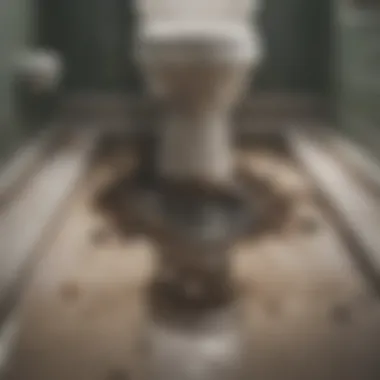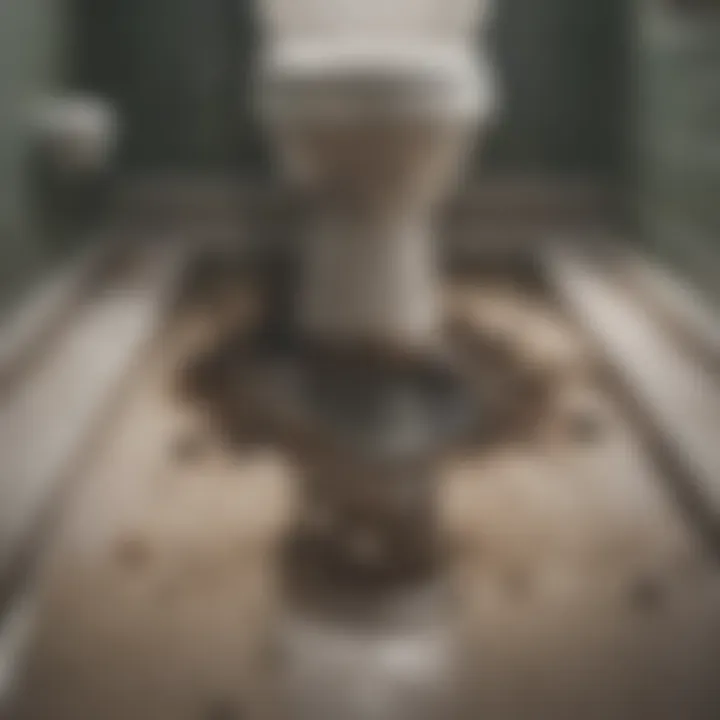Assessing Drain Cleaner Use in Toilets: Risks and Alternatives


Intro
In contemporary home maintenance, few topics generate as much debate as the use of drain cleaners in toilets. The effectiveness and safety of these chemical agents spark a need for comprehensive understanding. Homeowners often seek quick solutions for stubborn clogs. However, the implications of using such products are not always clear. This article aims to dissect the myriad factors involved, presenting an in-depth look at the benefits and drawbacks of drain cleaner use in toilets.
Feature Spotlight
When it comes to plumbing maintenance, understanding the tools and substances available can make a significant difference. Drain cleaners fall into various categories, each employing distinct chemical compositions and application methods. Their effectiveness varies substantially, depending on the nature of the clog and the type of cleaner used.
Types of Drain Cleaners
- Caustic Cleaners: These contain strong alkalis like sodium hydroxide. They work by generating heat and breaking down organic materials.
- Acidic Cleaners: These typically use sulfuric or hydrochloric acid. They can be quite powerful but may pose significant risks to plumbing systems.
- Enzymatic Cleaners: These use natural enzymes and bacteria to digest organic waste. They are generally safer for plumbing and the environment but may work slower than chemical cleaners.
Pros and Cons
- Pros:
- Cons:
- Quick resolution of clogs.
- Availability in numerous forms, including liquids and gels.
- Potential harm to pipes, especially older ones.
- Health risks due to fumes and chemical burns.
"Understanding the composition and potential ramifications of drain cleaners is critical for maintaining plumbing integrity."
Recommended Practices
To effectively address toilet clogs without compromising safety, several recommended practices can be adopted:
- Use Plungers First: Often, a basic plunger can clear the clog without introducing harsh chemicals.
- Consider Natural Alternatives: Vinegar and baking soda can create a potent combination for light blockages.
- Regular Maintenance: Scheduling routine checks can help prevent severe clogs, minimizing the need for chemical cleaners.
In summary, while drain cleaners offer a quick fix for clogged toilets, homeowners must weigh the potential risks against the benefits. A thorough understanding of options available can enhance decision-making and contribute to healthier plumbing systems.
Intro to Drain Cleaners
Drain cleaners play a significant role in modern household maintenance. Understanding their various types and functions is essential for homeowners. Toilets can present unique challenges that require careful consideration when selecting a cleaning method. Different drain cleaners serve specific purposes and their effective use can greatly ease plumbing issues. However, there are necessary precautions associated with their usage too.
Understanding Drain Cleaners
Drain cleaners are products designed to clear clogs in plumbing systems. They come in several formulations, which can vary from chemical compounds to more natural enzyme-based solutions. Knowing which type is suitable for a specific problem is very important. Chemical drain cleaners often contain corrosive substances that can effectively dissolve hair, soap scum, and organic matter in drains. However, they can also pose health hazards and risk damage to plumbing infrastructure if not used correctly.
Enzymatic drain cleaners, on the other hand, use bacteria or enzymes to break down organic material in clogs. They are generally safer for the environment and plumbing systems but may take longer to work compared to their chemical counterparts. There are mechanical methods too, such as plungers or augers. They require physical effort but can be dependable and eco-friendly solutions for clogs without introducing harmful substances into waste systems.
Common Uses of Drain Cleaners
Commonly, drain cleaners are used for:
- Clearing Clogs: Toilets are susceptible to blockages caused by various items, including toilet paper or waste.
- Routine Maintenance: Periodic use can help prevent build-up that leads to more severe clogs.
- Emergency Situations: When toilets overflow or drain slowly, drain cleaners offer a quick, albeit temporary solution.
It's crucial to understand when and how to deploy these cleaners. Using them indiscriminately can lead to more problems than they solve. Homeowners should be informed about possible alternatives and best practices. This knowledge can lead to better decision making and enhance the longevity of plumbing systems.
Types of Drain Cleaners
Understanding the types of drain cleaners is crucial when it comes to choosing the right method for unclogging toilets. Each category offers distinct compositions and mechanisms that can influence their effectiveness and safety. The type selected often depends on the nature of the clog, the specific toilet model, and personal preference regarding environmental impact and health considerations.
Different drain cleaners can be broadly classified into three main types: chemical, enzymatic, and mechanical. Each plays a unique role in addressing clogs, offering specific benefits and drawbacks.


Chemical Drain Cleaners
Chemical drain cleaners are widely used because of their immediate effectiveness in dissolving clogs. They often employ potent substances such as sodium hydroxide or sulfuric acid, which can break down organic materials. However, they carry risks, especially in the context of toilets. These products can create hazardous fumes and may react negatively with the toilet's materials.
Here are key points regarding chemical drain cleaners:
- Fast Acting: They often provide quick results, which can be appealing in emergencies.
- Risk of Damage: Chemical cleaners can deteriorate pipes over time, leading to costly repairs.
- Health Hazards: Users must handle them with care due to their corrosive nature.
While they can be effective, it's important to consider these downsides to make an informed choice.
Enzymatic Drain Cleaners
Enzymatic drain cleaners work differently than their chemical counterparts. They contain natural enzymes and bacteria that digest organic material. These cleaners are often marketed as environmentally friendly and safer for regular use.
The benefits of enzymatic cleaners include:
- Environmentally Safe: They are less harmful to plumbing and the surrounding ecosystem.
- Preventive Maintenance: Regular use can help maintain clear pipes and prevent backups.
- Non-Corrosive: They do not cause damage to pipes or toilet components.
However, their effectiveness may not be as immediate as chemical options. Patience is sometimes required to see results, which may not appeal to those needing quick fixes.
Mechanical Drain Cleaners
Mechanical drain cleaners encompass a variety of tools that do not rely on chemicals. These include plungers, toilet augers, and snake tools. They can be very effective in clearing clogs without the involvement of harsh substances.
Some advantages of mechanical cleaners are:
- No Chemical Risk: They avoid the potential hazards associated with chemical cleaners.
- Cost Effective: They often require less financial investment in the long run.
- Versatile Use: These tools can address clogs in different areas beyond toilets.
Nevertheless, using mechanical methods may require some physical effort and skill. Addressing tough blockages might require significant time and strength.
"Choosing the right type of drain cleaner is a balance between effectiveness, safety, and environmental impact. Consider all factors before making a decision."
In summary, recognizing the different types of drain cleaners can lead to more informed choices, ultimately enhancing the maintenance of plumbing systems.
Possible Dangers of Using Drain Cleaners
The use of drain cleaners, particularly in toilets, is not without its hidden risks. Assessing these dangers is essential for homeowners and individuals responsible for property maintenance. Many people are unaware of the real implications of using these products in their plumbing systems. This section explores the potential issues that can arise from the use of drain cleaners, from health hazards to risks to plumbing infrastructure and environmental considerations.
Chemical Burns and Injuries
One of the most pressing concerns associated with chemical drain cleaners is the risk of chemical burns and injuries. The active ingredients in these cleaners are often highly caustic. Common substances include sodium hydroxide and sulfuric acid, both of which can cause severe burns upon contact with skin. The concentrated nature of these products means that even a small spill can lead to painful injuries or permanent damage. For instance, a person attempting to unclog a toilet may inadvertently splash some product onto their skin, resulting in immediate pain and potential injury.
Furthermore, inhalation of fumes from these chemicals can lead to respiratory issues or other health complications. If proper protective equipment is not used, the consequences can be severe. It is advisable to follow safety guidelines strictly and ensure adequate ventilation in the area where these products are used.
Impact on Plumbing Infrastructure
Chemical drain cleaners can also have a detrimental impact on plumbing systems. While these products are designed to dissolve clogs, they can simultaneously corrode pipes, particularly older ones made from metal. Over time, repeated use of harsh chemical cleaners can thin pipe walls and lead to leaks. This not only necessitates costly repairs but can also create worse clogs as fragments of pipe may contribute to further blockages.
Considerations like pipe material and age are critical in determining whether to use these cleaners. In many cases, professionals recommend avoiding harsh chemicals in favor of mechanical methods, which do not pose a risk to the plumbing infrastructure. This approach can save homeowners from facing additional expenses resulting from damage caused by chemical cleaners.
Environmental Concerns
The environmental implications of using chemical drain cleaners are another area of concern that deserves attention. Many of the substances used in these products do not break down easily, leading to potential harm to water systems. When poured down a toilet, these chemicals often end up in local sewage treatment facilities or even bodies of water, which can negatively affect aquatic life.
Additionally, chemicals can leach into the soil, impacting vegetation and creating broader ecological risks. It is crucial for consumers to consider environmentally-friendly alternatives, such as enzymatic cleaners or mechanical methods, which pose less risk to ecosystems.


"The impact of chemical drain cleaners extends beyond immediate plumbing issues, raising questions about our collective responsibility toward environmental health."
In summary, the dangers associated with using drain cleaners in toilets extend from personal safety risks to broader environmental and plumbing infrastructure concerns. Understanding these risks enables individuals to make informed decisions about how to address plumbing challenges while minimizing potential negative outcomes. As the discussion progresses, it is important to explore alternative methods and preventive measures that provide safer choices for maintaining toilet functionality.
Toilets: Unique Challenges
Understanding the unique challenges toilets present is crucial for any discussion on drain cleaners. Toilets serve a specific function, which distinguishes them from other types of drains. Their design and the materials they handle add complexity when it comes to maintaining them. Proper comprehension of these challenges enhances effective decision-making for homeowners regarding plumbing solutions and maintenance practices.
Differences Between Toilets and Drains
Toilets differ significantly from standard drains, primarily in their structure and purpose.
- Design Purpose: Toilets are designed to handle solid waste and toilet paper, while drains generally transport wastewater from sinks, tubs, and showers. This distinction means toilets face different clogging issues.
- Water Flow: Toilets use a stronger flush mechanism compared to regular drains, which can impact how blockages occur and how they should be addressed. Toilets rely on gravity and water pressure to function optimally.
- S Trap Design: Most toilets utilize an S trap, which adds a bend in the pipe meant to hold water and block sewer gases. This design can trap unwanted materials more easily than the straight pipes typically found in other drainage systems, complicating the clearing of clogs.
The challenges these differences create should guide the approach toward unclogging toilets, and the types of products suitable for this task.
Factors Contributing to Clogs in Toilets
Multiple factors can lead to clogs in toilets, and understanding them helps in managing toilet maintenance effectively. Recognizing these factors minimizes the reliance on harsh drain cleaners that may cause more harm than good.
- Excessive Toilet Paper: Overuse of toilet paper is a common issue. Toilets struggle to break down large amounts at once, which can lead to blockages.
- Foreign Objects: Items such as personal hygiene products, toys, or sanitary items should not be flushed. These objects do not disintegrate like toilet paper and can lead to serious clogs.
- Hard Water Deposits: Mineral buildup can accumulate over time, narrowing pipes and reducing flow. This condition can exacerbate clogging issues.
- Infrequent Use: A toilet that is not used regularly may lead to stagnant water, which can gradually accumulate mineral deposits, leading to clogs.
- Toilet Design: Some toilets are more prone to clogging due to their bowl design or the flushing mechanism. Low-flow toilets, while water-saving, may not always provide sufficient pressure to clear waste effectively.
These factors emphasize the need for preventive actions, rather than defaulting to chemical solutions, which may not address the root problems effectively.
Can You Use Drain Cleaner in a Toilet?
The question of whether you can use drain cleaner in a toilet is a pertinent one for many homeowners facing stubborn clogs. Persistent blockages not only inconvenience daily activities but may also lead to damage to plumbing systems. Understanding the implications of using drain cleaners in toilets is critical for effective maintenance and safety. This segment evaluates the recommended use of these chemicals, their effectiveness, and the potential consequences that vary based on the type of drain cleaner used.
Industry Recommendations
Industry professionals often advise caution when it comes to using drain cleaners in toilets. Most traditional chemical drain cleaners are formulated for use in sinks and drainpipes, where water flow is generally more aggressive. Toilets present a unique setting. These cleaners can be corrosive and may damage toilet components, particularly gaskets and seals. Recommendations from plumbing experts generally highlight the following key points:
- Use specialized products: Opt for drain cleaners specifically designed for toilets, if you choose to use any. These products are formulated to be less harmful while still being effective.
- Follow instructions carefully: Always read the label and follow the manufacturer's instructions to avoid complications. Using too much can lead to overflow or backing up.
- Consider alternatives first: Most professionals suggest non-chemical methods as the first line of attack, reserving chemical cleaners for dire situations.
"Using the right tools and methods can save you both time and money in plumbing repairs."
User Experiences and Anecdotal Evidence
User experiences with drain cleaners in toilets reveal a wide spectrum of outcomes. Many individuals recount that while some products provided immediate relief from clogs, others caused additional issues:
- Short-term success: Some users report success with liquid drain cleaners, noting they were able to clear blockages quickly. However, the long-term effects on plumbing systems remained uncertain.
- Negative consequences: Others have experienced deterioration of toilet seals or corroded piping after using strong chemical cleaners, highlighting the potential risks associated with such products.
- Preference for natural solutions: There is a growing number of anecdotes advocating for natural alternatives. Products made from enzymes or those that harness the power of baking soda and vinegar often provide a safer means of addressing clogs without harmful effects.
Alternative Methods to Clear Toilet Clogs
The significance of exploring alternative methods to clear toilet clogs cannot be overstated. Homeowners face various issues when dealing with clogged toilets, and the use of chemical drain cleaners may not always provide the optimal solution. Understanding the merits of different techniques can lead to safer and more effective plumbing maintenance. Each method has its advantages and considerations, which can help determine the best approach for a specific situation.
Plunging Techniques
Plunging is often the first line of defense against toilet clogs. This method involves using a plunger, specifically designed for toilets, to create a vacuum and force the clog to move. Effective plunging requires a specific technique. Here are steps to consider:
- Select the Right Plunger: Ensure it's a flange-style plunger, which is more effective for toilet bowls.
- Fill the Bowl: Add water if necessary to ensure the plunger is submerged.
- Create a Seal: Position the plunger to cover the drain hole effectively.
- Push and Pull: Firmly push down and pull up repeatedly without lifting the plunger off the drain.
This method works well for managing minor clogs caused by toilet paper or small objects.


It's crucial to be patient and persistent. Sometimes, multiple attempts may be needed to clear the blockage completely.
Using a Toilet Auger
For more severe clogs, a toilet auger, or toilet snake, may be required. This tool is designed to reach deeper into the toilet’s trap, allowing for better blockage management. Using a toilet auger follows these steps:
- Insert the Auger: Place the auger into the toilet bowl, directing it toward the drain.
- Crank the Handle: Turn the handle to extend the cable deep into the drain, where blockages may be located.
- Break the Clog: Use the auger to push through the obstruction or to hook and pull it out.
Using a toilet auger can be an effective way to address persistent clogs that a plunger cannot resolve. Still, users must proceed with caution to avoid damaging the toilet.
Natural Drain Cleaning Solutions
For those who prefer environmentally friendly options, natural drain cleaning solutions are worth considering. Many household items can help clear minor clogs without chemical cleaners. Here are a few options:
- Baking Soda and Vinegar: Pour a cup of baking soda followed by a cup of vinegar into the bowl. Let it sit for about 30 minutes, then flush with hot water.
- Salt and Baking Soda: Mixing salt with baking soda and adding hot water can also facilitate clog removal.
These solutions are less harmful and more sustainable. They work well for minor build-ups but may not be effective for significant blockages.
Preventive Measures for Toilet Maintenance
Proper upkeep of toilets plays a vital role in ensuring their longevity and functionality. Ignoring maintenance can lead to serious issues and expensive repairs. Preventive measures are crucial not only for avoiding clogs but also for maintaining an efficient plumbing system.
Regular Inspections and Cleaning
Conducting regular inspections is essential for identifying potential issues before they escalate. Homeowners should check for signs of leaks, cracks, or corrosion. Cleaning the toilet regularly helps to remove buildup of hard water deposits, stains, and bacteria. Certain cleaning solutions can effectively help manage the deposits that may form in and around the toilet.
Some important tips for inspections and cleaning include:
- Spotting leaks early: Look for water around the base or under the tank.
- Checking toilet functionality: Make sure the flush is strong and consistent.
- Using the right cleaning products: Choose biodegradable or non-toxic options to avoid harming the plumbing system.
Maintaining a clean toilet is not just about aesthetics, but it also promotes hygiene and functionality. Regular cleaning eliminates odors and prevents mineral buildup.
Educating Household Members
Involving all household members in maintenance practices can lead to better toilet care. Educating everyone on what can and cannot be flushed down the toilet is very important. Many people overlook the potential impact of improper disposal habits.
To ensure effective education, consider the following:
- Create a guideline: A simple list of what is safe to flush can be a useful reference.
- Discuss problems openly: Encourage conversation about any issues noticed in the toilet.
- Involve all ages: Make sure even children understand the importance of proper usage.
By making toilet care a collective responsibility, households can significantly reduce their risk of clogs and plumbing issues. This proactive approach saves time and money in the long run.
Ending
The examination of drain cleaners in toilets is a vital aspect of home maintenance. This article not only delves into the efficacy and safety of these products but also addresses the nuances that accompany their use. Understanding the implications can greatly influence how homeowners approach plumbing issues.
Summarizing the Main Points
In assessing the use of drain cleaners in toilets, several pivotal elements emerge:
- Types of Drain Cleaners: There are chemical, enzymatic, and mechanical options available. Each serves a distinct purpose and varies in its suitability for toilet applications.
- Dangers and Risks: The potential for chemical burns and environmental harm cannot be overstated. Homeowners must recognize the repercussions of using these cleaners on their plumbing systems.
- Alternatives: Plunging, toilet augers, and natural solutions present viable alternatives to harsh chemical cleaners. These methods not only clear clogs but also preserve the integrity of the plumbing.
- Preventive Measures: Regular inspections and educating all household members about what can and cannot be flushed down a toilet can significantly reduce the frequency of clogs.
This summary encapsulates the primary points that illuminate the challenges and considerations of using drain cleaners in toilets.
Final Thoughts on Drain Cleaners in Toilets
Ultimately, the debate surrounding the use of drain cleaners in toilets reveals a complex intersection of practicality and safety. While the immediate convenience of using these products is apparent, the long-term implications warrant careful consideration. Homeowners should weigh the benefits of rapid clog removal against the potential risks posed to their plumbing systems and health.
"Knowledge of the risks and benefits associated with drain cleaners is crucial for making informed decisions in home maintenance."
By framing our discussion in the context of safety and effectiveness, we lay the groundwork for responsible plumbing practices.







